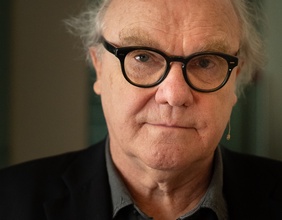Danke an alle Beteiligten
Uncage Cage
Eine Befreiungsaktion für John Cage durch kreative Hörerinnen und Hörer von Ö1. Wir haben Sie gebeten, uns ein Soundfile mit Ihrer persönlichen Hommage à Cage zu schicken! Mehr als 70 Kompositionen sind dabei eingetroffen. Jetzt war die große Schlussaktion.
27. April 2017, 15:40
Uncage Cage live in the Vienna Funkhaus
The recording of this live event was broadcast at 11:03 pm on 19 December 2012 in the last Zeit-Ton-Magazin of the year. You can also find all the photos of the event on the programme's Internet page.
more
The composer and universal artist John Cage wrote music that sounded wonderful in the very traditional sense, but at the same time he was an extremely radical composer who created exuberant sound orgies, and he also composed one of the most famous and the quietest pieces of the 20th century, the three-movement rest, 4'33".
Radio as amplifier
A few years later, in 1962, under the title 0'.00", he raised this approach to an even more radicalised level and gave his performers a short verbal instruction to "in a situation provided with maximum amplification perform a disciplined action."
It is precisely this that Ö1 invited its listeners to do. The maximum amplification of the disciplined action was provided by the radio.
We played a number of your contributions on the radio during our focus on John Cage, and the selection was also to be heard at the end of the John Cage anniversary year in the Zeit-Ton Magazin series on 19 December 2012.
What you sent us
Richard Faderny
SineCage": C-A-G-E in sinus tones of the same length, with only variation in pitch. Without Cage? Or without a cage? Or is the cage surrounded by an electric fence that buzzes away in sinus vibrations? Or could you call this buzzing itself music, and why should you? Is not everything music? Is silence not also a sinus tone with zero amplitude? Or are the actual zeros us who imagine something out of simple vibrations? Are our inner vibrations also structured so simply? Do we want simplicity and quiet at all, or do we prefer to drown silence with unearthly sounds and even more unearthly overtones?
Il silencio, sine Cage ...
Mathias Lenz
Phoning 0664 73 11 60 34 puts you through to a tape loop. Each run of the loop plays what has just been said.
1.) Call the number.
2.) Say "There is no one here. Who is speaking?" and repeat this until you hear a reply.
3.) Listen until the carpet of sound fades away, or hang up.
Richard Faderny
"Sadore": concentrated melancholy
Klaus Joachim Keller and Stephan Hafner
A piece of birch with Klaus Joachim Keller (cello) and Stephan Hafner (keyboard)
We are both musicians and artists, and during a project visit to Getberg (northern Sweden), we found a fallen birch tree in the forest. We took a few pieces of bark with us and later discovered that on the inside of these pieces there were dots that looked very much like musical notes. Back in Vienna, we placed a stave over these dots and made a very disciplined recording of the piece, trying as far as possible to stick to the existing notes. What you hear is the composition of a northern Swedish birch played in the treble and bass clef.

A piece of birch
(c) Klaus Joachim Keller und Stephan Hafner (Keyboard)
GUWISAKALIGULI
The "GUWISAKALIGULI" children's and young people's orchestra consisting of 73 children and young people aged between 4 and 16 performed a shortened version of John Cage's 4'33". For the mostly very young members of the orchestra, the task of being completely quiet required a maximum of discipline. And although the orchestra achieved its aim perfectly, the audience's reaction meant that there could be no question whatsoever of silence.
Yout Tube - GUWISAKALIGULIs Hommage to John Cage
denovaire
"silence is...."
Ö1 has naturally an unmistakable sound made up of the announcers, the music, the energetic nonmaterial cloud of what is said and what is not said. In addition, all this is heard through the ORF's (high-end) equipment. So I ask myself what does the programme, the channel sound like, what does silence sound like on Ö1 if it is inflated, made audible? Silence in the channel, raising the gain of the master fader, taking down the compressor threshold, in other words raising silence to -1 dB, and we hear our Ö1 … crackling, rustling, scratching… As Cage said, there is no silence, not even in the final analysis, since if you are surrounded by silence, you hear the vegetative system ... or the channel … Everything is sound :)
Christoph Renhart und Jakob Reichsöllner
Prelude for 4'33''
music for at least two players
Prelude for 4'33'' is an attempt at a musical reconstruction of the hushed big bang before John Cage's opus of nothing. Two or more performers shout the word SILENCE synchronically and accurately at the two point five beat, and this is amplified to the maximum by the human voice and the piano's soundboard. The disciplined action is preceded by a disciplined anachronistic disciplining command: "On two point five – silence". As we know, the rest is silence – or history.
You can see a video of the event on You Tube.

1 The use of a stopwatch is recommended. Mind that the device itself is not supposed to produce any sound when being used.
2 It is necessary to use a rather long grand piano in order to obtain a sufficient instrumental amplification.
The positions of the players are appointed in the sketch below. Speak very clearly and use a British accent
(c) Christoph Renhart
Stiff Toes
Microwave
The band Stiff Toes shows what can happen in a kitchen when the microwave is on.
Ben Pascal
"Sixth Piece"
In 2010, I regularly played piano with my aunt (who has Down's syndrome). These were always free improvisations. Moreover, we played on an old out-of-tune piano. I recorded a total of nine pieces that can certainly no longer be reproduced.
I attach the sixth piece.
Bernhard Bauch und David Schweighart
Sunday, 26.5
A birthday serenade for John Cage
Recorded: 5 September 2012, Kleylehof, Burgenland
Instructions
1. Take a television programme
2. The number of channels is determined by the number of performers.
3. From the listed broadcast times, a common starting and finishing time is selected.
4. The broadcasting times less the starting time determine the action times in minutes.
5. A suitable place is selected where the possible acoustic actions are to be listed.
6. Each action is given a number.
7. A random generator attributes a number to each starting time and hence to an action to be performed.
8. This produces a list of actions that are to be carried out at specific times by the performers with a stopwatch.
In the case in point, the performance was as follows:
The starting point was the television programme in the Kronen Zeitung newspaper on 26 May 2002, the ORF 1 channel being performed by the first performer, ORF 2 by the second musician.
The starting time was 06.00, the finishing time was 20:15, resulting in a length of 14 min 15 seconds.
The work was to be performed in the attic of the Kleylehof near Nickelsdorf in Burgenland.
The instructions for action included: playing a random chord on the piano, switching the radio on or off, or changing the frequency or the waveband, opening and closing cupboard doors, switching on two megaphones hanging from the ceiling and playing a pre-recorded loop, stamping across the stage once, etc
Richard Schmetterer
Prelude VI
I put my five month old daughter on my lap and sat at the piano, placed two sheets of music with the title Prelude VI by J.S. Bach and asked her to perform the work with a maximum of discipline. What you can hear are both the sounds of the piano and vocal contributions, the microphone being hit and noise caused by the recording. The work is to be interpreted as a comment on the increasing professionalisation of performers and as a comment on the freedom of interpretation, and is dedicated to both John Cage and Barack Obama.
Hans Hauer
As I was searching for my inner voice, I listened to my heart… and it began to sing.
Inko Martín
"He listens"
"If a man does not keep pace with his companions, perhaps it is because he hears a different drummer. Let him step to the music which he hears, however measured or far away."
Henry David Thoreau
Ingredients:
A spoon
A screwdriver
A recording device
A hand drum
A computer
Preparation:
OUTDOORS. FOREST. DAY
1. Dig a hole.
2. Place the recording device in it
3. Switch on the recording device and cover it with earth, with the microphone 5 cm under the soil.
4. Walk across the (buried) recording device in various qualities (cheerful, sad, heavy, light, stressful, imagining yourself to be an important businessman, a pregnant woman, with nails in your shoe, being pursued by a rhinoceros, …)
5. Dig up the recording device and record the sounds of the surroundings for 1 min.
INDOORS. MY ROOM. DAY
6. Cut the recorded tracks into pieces of 1 minute each and mix.
7. Listen to the recorded sounds of the surroundings on headphones and beat the hand drum to the rhythm of the birds twittering. (Record with the recording device.)
8. Mix the preceding step with the noises of the walking.
9. Result:
A homenage to John Cage.
Richard Faderny
"Tick17": The ticking of the kitchen clock, the song of birds comes through the open window, once again someone is playing around on the synthesiser; all of this is guaranteed not to be noise-free.
KLIRZ
19 July 1937: The Nazi regime opened the "Degenerate art" exhibition in Munich. Room 9 displayed abstract works (Max Ernst, Paul Klee, Kurt Schwitters and others). This room bore the title "Utter madness".
The Room 9 Symphony is dedicated to all ostracised artists. Cage would very likely have been classified as degenerate by the Nazis.
First movement: the growing up of an idea
Concert guitar, cat chewing cat biscuits. Particular thanks are due to the lady cats Paris and Sydney, and the tomcat Joshy for their animated performance.
Second movement: choosing a medium
Theremin, birdsong and creaking boot lid
Third movement: fight and struggle
KLIRZ guitar
Fourth movement: Catharsis and complete exhaustion
Ukelele and 16 crates of dynamite (as a rule concert hall managers refuse to allow this movement to be performed)
Markus Wiederstein
Kitch for Cage
Duet for dusting robot and observer with a wooden spoon
The place chosen for the performance is a moderately dusty kitchen floor including entrance area. A dusting robot travelling autonomously across the floor is placed on the kitchen floor. The following four kitchen utensils are placed in the entrance area: the lid of a rice pan, a glass measuring beaker, an onion jar without lid and a milk jug made of Lilien porcelain.
An observer sits on the floor in front of these utensils and follows the path of the robot. Whenever the robot changes direction, i.e. when it hits one of the four walls, the server hits a kitchen utensil assigned to this wall with a wooden spoon. The utensils sound according to the following system:
Rice pan – F
Measuring beaker – A
Onion jar – D
Milk jug – E
(Attributing the four walls to C-A-G-E might be F-A-D-E the German word for "boring").
The observer must be very disciplined in order to react with the wooden spoon as accurately as possible when the robot hits the wall, and should not allow himself or herself to be distracted by meditative thoughts about the path and the objective.
The path of the robot measuring out its cage and hence the resulting sequence of sounds depends on the starting point, the robot path-change algorithm, the size and shape of the room, and is hence not predictable. Nevertheless, each stage from one sound to the next is determined by the current path of the robot and requires the observer to predict as accurately as possible the next utensil to be hit. The piece ends when either (a) the robot's battery or the observer's concentration is exhausted, or (b) a significant time (such as in the present case 16'33") is reached.
Christian Lewarth
In the "Lindenheim" in Kufstein, my mother's house (and before that my grandparents' and before them my great uncle's/aunt's), there is a staircase that I often swept during my childhood, and that like the entire wooden house was built in 1932. I was there in September and imagined the steps as huge wooden piano keys on which I played scales.
My performance (on the afternoon of 29 September 2012) proceeded as follows: Quickly up to the top floor and back down again (nine steps as far as the landing where the microphone was placed and then a further nine steps to the top). The second time, up and down as quickly as possible. Then at normal speed, but legato, i.e. tying all the "notes" to each other as I went. Then the fourth time I tried to go up and down without causing any noise whatsoever. This often created a creaking sound, while the footsteps themselves were less audible. I then went down the steps into the cellar and back up again (here there are eight steps down to the landing and then a further six steps to the cellar door). This would thus be the inversion. But this time I didn't sweep up.
I "messed up" (stepped wrong?) the first few seconds and then went back down the first steps before I began again at second 16.
KLIRZ
they frowned upon him (Absurdicon for electronically manipulated effervescent tablet, bedroom door and endodyne guitar)
To be taken note of by all those who dismissed John Cage as a charlatan, a fraud and a minor artist.

"While we were going through the household bills together, my wife looked at me and smiled: 4'33!!!!!", wrote Otto Rastbichler.
(c) Otto Rastbichler
KLIRZ
the egg - an eye - John Cage (Capriccio for endodyne guitar)
Sunday morning. The smell of coffee. You in a dressing gown. Everything as usual. Full of anticipation, you remove the top of your breakfast egg, but discover that instead of a soft boiled yoke, an eye is looking at you! It is wearing a monocle.
This was the day John Cage entered your life.
Alexander Graf
"stradala". A deliberate composition made up of acoustic events. I made these field recordings during the La Strada Festival at the Schöckl and arranged them with a thorough-going lack of discipline. The sound installations there that were left not only to chance, namely the strength of the wind/the weather, inspired me to make this collage.
Pupils of the 5th and 7th grades of the Seitenstätten monastery grammar school
Tape room
On the occasion of the 100th anniversary of John Cage's birth, we decided to participate in the Ö1 "Uncage Cage" competition. In our work, we have tried to shape different sounds to create a large whole. We only used electronic devices such as a metronome, an electric piano, mobile phones…. At the beginning of the work, a single metronome plays, but as time goes by other instruments join in, and then fade out at the end. We hope that the piece is of general interest.
Pupils of the 5th and 7th grades of the Seitenstätten monastery grammar school
"You need neither wonderful instruments nor lots of money to make music." We wanted to make this idea clear in our work "80 seconds of rhythm". It was an important fact that John Cage is also bound to have recognised. He also developed extremely creative pieces of music with cheap means such as screws in the piano or radios. We used the following devices for our work: an alarm clock, a strange taboo-squeaking thing, a spoon hitting a cup, a half-empty water bottle squeezed together, a ballpoint pen and a table that was used as a drum. In addition, there is the coughing of one performer.
Performers: Michaela Haimberger (alarm clock), Luzia Gstettenhofer (taboo-squeaker), Eva Wagner (cup + spoon), Martina Bachleitner (water bottle), Christoph Winkler (coughing), Manuel Donschachner (ballpoint pen), Susanne Schnabel (table drum)
Pupils of the 5th and 7th grades of the Seitenstätten monastery grammar school
"Burn out". In our age of continuous modernisation, there is no longer any time for the essential and simple things in life. Composition for prepared piano, voice and a number of mobile phones.
Performers: Miriam Zöchling, Theresa Graf, Lukas Infanger, Miriam Deinhofer, Simon Spahn, Lisa Jung
Pupils of the 5th and 7th grades of the Seitenstätten monastery grammar school
Random chaos. To hear the central element of something that is correct is easy, but hearing what is correct out of much that is wrong is art.
The Entertainer (on the piano): Georg Moser
Cymbals: Moritz Ruspeckhofer
Xylophone: Lukas Wieser
Drum: Magdalena Froschauer
Drum + rattle: Michaela Fehringer
Guiro: Verena Hirsch
Cymbals: Hannah Edlinger
Recording: Robert Hintersteiner
Albert Dambeck, Kevin Gütlein
In the course in modern music at the Passau Montessori School, the idea arose of creating a homage to John Cage. After a Cage symposium in Munich, I finally got together with Kevin Gütlein, a pupil on the course and an enthusiastic devotee of modern music, and recorded the following trilogy. Using electronic music programs on the computer, various monochords, a mandolin and noises from the surroundings of our room (iron door, vending machine), we created microtonal melody lines based on drawings and surrounded them with noises, white noise and sounds.
Lena Zeger
Backgammon – luck, or perhaps not? "Click click click" is the sound as the black and white counters move, sometimes rhythmically, sometimes less so, across the board. Towards the end, the atmosphere becomes tenser, and there is almost a feeling of stress as each counter is dying to reach the end as quickly as possible. Although it is mainly luck that determines the path. Or perhaps not after all?
Pupils of the 7th grade of the Feldgasse Grammar School
0:00 - Pupil action
The pupils of the 7th grade of the Feldgasse 6-8 Grammar School in Vienna's 8th district carried out an acoustic disciplined action in the course of music classes and reflected on their activities.
A: The ticking of the clock stands for the time you wait in oppressive silence, like a microcosm. The impulse tears you from this "world". The impulse serves as a metaphor for being called.
B: Mankind in the waiting room of time.
The before and after mankind is symbolised by the ticking of the clock.
The impulse/bang stands for the short but unmistakable influence of mankind on history (of time).
C: The situation is divided. Silence, ticking & an impulse. The silence interrupted by ticking – a pointless equality.
The impulse breaking the silence – powerful but worthless.
Is it only the connection, the contrast, the comparison, the reciprocal dependency, is it only through these that meaning is created?
What is silence without impulse…
What is an impulse without a context…
What do the two sound like?
KLIRZ
"guaranteed tomato-less Cageup". 16 hearts, 16 souls, 16 vocal chords and the compression output of 32 lungs combine to create an unwritten score. But the heads know that it is about nothing. Then smile. Thank you John.
Josef Ziervogl
"Quiet". We. Two men (Josef Ziervogl, Martin Zeller) sound off whatever comes spontaneously one afternoon. In this moment there was quiet, relaxation, but also the love of sound and flowing let the theme in. We didn't know. It was only afterwards that we noticed what our subconscious had revealed. If you are relaxed enough to record what is present right now, that's the most wonderful thing that there can be. Even I catch myself striving where I notice a fault instead of working with what is present.
Josef Ziervogl
"The satisfaction of having accomplished something". The second contribution by Martin Zeller (piano, vocals) and Josef Ziervogl (vocals) deals with the satisfaction of having accomplished or completed something. You are relieved, happy but you are also tired from doing something. It is an exuberance in which all the tension is released and what you have done is reviewed. We improvised spontaneously on this topic and this led to the work that you now have before you. Since our improvisations are never practised or repeated, it may now be more or less successful. However, this made it spontaneous from our hearts. Nothing imposed but simply the first feeling that arose.
Josef Ziervogl
"I stand and sound from myself to myself". My voice is as it is. I am as I am. The world is as it is. Neither good nor bad. I stand here and sound from myself to myself, because I feel simply like this in this moment. Whether the listener finds this moving or not, I do not know. Of course, it would be an appreciation if it was so, but even if no one likes it I bear within me the sensation of the moment when I produced it.

Gerlinde Wurth sent us this still soundless "birthday serenade" for John Cage.
(c) Gerlinde Wurth
Josef Ziervogl
"Anger – born from sorrow". This contribution arose spontaneously with what I see as an intense title in mind. Anger and sorrow are for me and probably for very many people, very intense forms of expression. Who never cursed his parents? For me, this is the admission that many things were not right and that letting emotions out is an essential element for achieving inner healing. The performers are Martin Zeller (piano, vocals) and Josef Ziervogl (vocals).
Richard Faderny
"Waterfall": Down from the heights in Digi-dale
Christine Aldrian-Schneebacher
Sonatina for piano and two floor cloths
Household activity for dusting 85 piano keys with great discipline and care, performed on 26.9.2012, 8.07 am; microfibre and cotton on wood and ivory; instruments: Stingl upright piano (around 1920), creaking piano stool (around 1930), ex-T-shirt (around 2000), microfibre cloth (around 2010)
Benjamin Klug
One of the pieces in which I attempt to place known instruments in a different context and to give new functions to everyday utilitarian objects and waste products. The random principle and the act of producing (including all secondary sounds that result) play a very decisive role.
Instruments used:
-double bass
-mizma
-bits of wood
-tin cans
-pans
-tin-can guitar
-floor tom
-hanging tom
-cymbals
-African wooden xylophone
-electric organ
-organ pipe
Florian Steiner
Cage for children
Children's song on prepared glockenspiel for early musical education. Materials used: glockenspiel (Studio 49), screws, wall plugs, clips.
Wolfgang Heine
The attached sonatina, "Rain in a-minor", reaches a climax above all in the third movement with choirs of angels from the € 99 Yamaha synthesiser that I as an old-age pensioner saved up for from my meagre pension due to an absence of space to put my grand piano. The recording was created as a good quantity of Veltliner white wine dripped over my liver, and as I was listening to the dripping rhythm of the MiniDisc player via headphones. (Synchronisation not always successful, unfortunately.) Beforehand, there were still plenty of things to solder in order to transport the quantity of sound onto the hard disk.
Wolix.at - Rain
Eva Mayer
Title: AAApplaus
At a class recital by the oboe pupils of a Vienna music school, I recorded their attempts to tune to standard pitch A and processed the results on the computer. The parts of the tuning up were only looped and not processed electronically any further.
Katharina Vötter and Christian Manuel Oliveira
This Cage homage was created as part of a Marshall McLuhan evening. All the noises were recorded in Linz, the only exceptions being an aircraft taking off and the noise of the sea to which the flight from Linz was going.
We are two actors at the Linz Provincial Theatre. Our aim was to make music with everyday noises and to play with random chance – which developed above all in the following combination of the noises.
What is interesting is the ability of people, despite the noises being unconnected, to build a story, to develop linearity, to have associations that appear logical despite the completely unrelated origin. This sound collage was performed on 1.12.2011 in the Roter Krebs, Linz, with the public sitting between four loudspeakers and hearing a different track from each corner.
David Prikoszovits
Since when I'm studying I make a break, I always draw something.
Helga Bimminger
When I read Rainer Elstner's portrait of John Cage on your Ö1 homepage, the following lines immediately struck me:
"Cage was fired up by a statement by Fishinger: All you have to do in order to release what is inside everything is to stroke this object and draw out its sound. This sentence corresponded exactly with the ideas that had long been slumbering within Cage."
I have recently become involved with the sound of stones. The most amazing sounds are slumbering within what are assumed to be silent giants. Not much is needed to release them.
foto-blog.mabix.net
Daniel Jarosch
"Allah Birds": I recorded this with a simple MiniDisc recorder and a cheap stereo microphone on the roof of a guesthouse in Fort Kockin in the southern Indian state of Kerala at sunrise in February 2009. The singing and squawking of crows, parrots and countless other birds sounds out above the morning city. A bell at a Hindu temple close by welcomes the rising sun. At around 1 minute 45, the first muezzin begins to sing in the distance. Many others join in from mosques closer by. From minute 3, the air is filled with the unearthly blend of the voices of many muezzins and countless birds. There is an ambivalent parallel between the song of the birds and the call to prayer. The birds on the trees and roofs, the muezzin down from the minarets: are they singing with the joy of life, to praise God or are they marking their territory acoustically? Do the birds see the muezzins as other birds?
Valentin Duit
The idea: To produce a posthumous (because only developing through or rather with the sound) graphic score (or the like) by means of a disciplined musical action (without break at 120 bpm in continuous semiquavers or quaver triplets, drawn first with pencil then with red felt tip until the pencil or felt tip was no longer putting any colour on the paper).
Thomas Radlwimmer
It was during the discussion with Antoni Tàpies that I came across John Cage (in the context of Dadaism and perception philosophy theories), who fascinated me firstly through his provocative compositions and secondly through his interesting mental concepts. Although at first sight these are two very different artists, on closer examination one finds parallels and overlaps – above all in the fields of perception, the significance of the everyday and the expansion of the concept of art.
YouTube - 3'34"
Oliver Peters
"3:22": This moment was recorded by me in a shelf of books, DVDs and CDs in the American Memorial Library, Berlin.
Helga Bimminger
"Looking for lost silence"
my attempt at C-A-G-E on the loop machine with harp and voice.
12 august 1992:
for 4 minutes and 33 seconds, cage is still caught within himself here…
C-A-G-E
he marks step
looking for lost silence
and
falls
perhaps
into a state of meditative trance …
Suddenly
it is there:
TRUE SILENCE
Mohses
"If you celebrate it, it's art..." - It is on this statement by John Cage that the performance "Sektstück für John Cage" is based, played by the public at a Cage birthday anniversary event on 5.9.2012 in the Autonomen Kulturzentrum Metzgerstrasse 8 in Hanau (Germany).
The instruments used were bottles and glasses of sparkling wine, paper vuvuzelas, cutlery, voices, cigarette lighters, sparklers and a metal barrel in which the glasses were smashed at the end – all backed by a highly decelerated instrumental version of "For he's a jolly good fellow" – and with 33 seconds of silence in the middle.
Background: In 1991, John Cage created the work "Five Hanau Silence" to support the building at Metzgerstrasse 8, in Hanau, occupied since 1986, and since then used as an autonomous cultural centre.
See also: Sterneck
Indra Tjoa
cage: age: 100''
The only musical instrument that I currently have available is my childhood recorder, and it is for this that the birthday serenade is composed. Very carefully, I take up my childhood recorder position, I stand straight with my two soles firmly on the floor, my elbows slightly away from my body at precisely the right angle, my lips placed on the recorder such that the mouthpiece does not disappear into my mouth, I'm breathing gently, each sound is carefully blown tüü-tüü-tüü (1). The serenade lasts one hundred seconds because it is played to celebrate the hundredth anniversary of his birth. The childhood (recorder) sequence flies past. The remaining time (2) I spend in silence.
(1) Although I have often wondered how recorders are played internationally, since ü is not a very common letter, and so variation 1: international version on tuu tuu tuu.
(2) Since time is pressing, however, and age means not only my body age but also a period of history, but John Cage is ultimately immortal, the time can be extended at will.
Hans Hauer
"Babylon". Like John Cage, with the help of chance (by chance, I couldn't get to sleep last night).
I prefer to leave interpretations to the listeners.
Robert Wacha
I am an electronic musician and cannot play a single normal instrument. In a creative crisis I adopted the strict principle of producing an entire album without a single electronically generated sound. It was hell. Old zithers from a flea market, glass bowls and sound cuts from musician friends, cut up and laboriously glued together. But the result was acceptable and important to me. The entire album can be found at Backlab
Richard Faderny
´"Tesiore": Melody and rhythm run in a cage without the possibility of release. If "desire" is the general human yearning, "Tesiore" is intended to be the artificial metallic digital yearning: an interstellar wanderlust and homesickness.
Jella Jost
I love to rerecord old material that I produced – or actually that means very recent – and to change what is provided to be changed or possibly can no longer be changed. "Hammam" was created in Vienna a few years ago as an experiment in love, voice, water and warmth.
I like going there. I was alone and naked with myself and an acoustic artist and a recording device as I improvised on the hot stones. The approximation to the unexpected. Simple. Plain. Peaceful.
Werner Chromecek
The piece "G major, with discipline" is performed on a B-flat clarinet (Böhm system); the G major scale is played staccato from g to g', but, between each note, the musician must run twice with discipline up and down the room in which he or she is playing. Actually, despite the demanding drill, the individual sounds should come over clear and peacefully, which unfortunately did not succeed very well with the F#, despite a high degree of discipline.
Hans Hauer
The attached brief "vivacissimo", recommended to be played in fortefortissimo, was created after listening to the news, the morning news 1, the morning news 2, the news, the midday news and the news one after the other.
Hans Hauer
It may well be that John Cage, like Olivier Messiaen, took natural sounds as the basis for his compositions. Interestingly, with the nightingale, not one verse is entirely like another. Recorded on Torcello in 2008.
Akos Hargitay
I am a dancer, choreographer who lives in Vienna since 2006. I was & still researching and also created several performance - one to dedicated to Cage - with the basic idea how to use the dance and the trend sport parkour movement on a scaffold - the physical movement created a direct sound scape, this sound scape was manipulated by Gammon, sound artist from Vienna... below is one of our experiment what we would like to dedicate today for Cage:
Sound Parkour
Harald Kaffenböck
Put together very quickly after a wonderful night with Ö1.
Patrik Lechner
The piece that I am sending you is called 2'16.5, 2 minutes 16.5, and I don't need to explain the reference. The discipline is found in the specification, the maximum amplification is added by me, practically as a deliberate misunderstanding of the specification. It is a work that is actually DC offset. All samples of the piece have the value +1 on both channels. In the ideal case this causes a click at the beginning and end of the piece, and without further processing the membranes of the loudspeakers from which it sounds would achieve maximum amplitude, which will not happen since your broadcasting line is certainly equipped with high pass filters, compressors and all kinds of AGC equipment. What will sound at the beginning and end is essentially a kind of impulse reply from your transmitter; I am curious what will happen!
Markus Schneider
"Improvisation with a prepared child's guitar". A child's guitar, out of tune in no particular way, was prepared using a stick of Labello. Two low strings were tensed over it and it was therefore possible to play on both sides of the movable bridge, three strings below, and only the highest vibrated freely but could be drawn over the bridge. The guitar (strings and body) was played with a drumstick, a medicine bottle and conventionally with the fingers.
Leonard Eröd
Self portrait of the artist cleaning his teeth.
Action, carried out with maximum discipline on 5.09.2012 at 7:58 am, immediately after the invitation to participate in the "uncage Cage" action was announced.
Room: bathroom, approx. 5m2 (maximum possible amplification thanks to wall titles)
Instruments: plastic toothbrush, toothpaste, ceramic wash basin, water.
Julia Tieke
Your invitation was a welcome occasion to finally take out and process the recordings of my Egyptian singing lessons in Alexandria in winter 2011/12. I therefore attach my work "Sing like an Egyptian" – a very disciplined musical action … I have selected a title (self) ironically that addresses both the postrevolutionary and now faded Egypt hype as well as my own position in it.
With the "poor" cutting, I emphasise the process of practising and repeating, breaking off and starting.
Richard Faderny
The name of John Cage is an obvious invitation to set it to music. For this reason, the work begins with the notes C-A-G-E and continues with A-B-A-G-E, leading to the title "CAGE ABAGE". The last notes are once again CAGE. It all came out of the computer.
Agustín Castilla-Ávila
My cycle "Caged Music" for one to four prepared guitars has a strong link to John Cage; not exactly direct, but strong. In all the pieces, I have amplified the intimate and rhythmic character of the instrument. The first part (solo guitar) is inspired by the American song "Unchained Melody".
Agustín Castilla-Ávila
"Caged music 2" for two prepared guitars, performed by the Noiz Guitar Duo on 18 August 2012 at the Asociación Cultural Áureo Herrero in Ávila, Spain. Of all four, this composition is closest to John Cage. There is no particular theme and no particular development; I only focus on the percussive nature of the prepared guitar strings. I conceived of this composition almost as an encore, as fun after the concert. I was surprised to see how many musicians would like to have fun at concerts: I am often asked about a version of this small piece for other instruments.
Agustín Castilla-Ávila
"Caged music 3" for three prepared guitars, was performed by the Athenaeum Guitar Trio on 5 May 2012 at the Athens Atheneum Conservatory. In this piece, I "caged" the theme of the Spanish composer Tárregas "Recuerdos de la Alhambra". John Cage's aim was often silence; in this work for prepared guitars, my aim was not quite silence, but something very similar: the intimacy of the music.
Agustín Castilla-Ávila
The last part (guitar quartet) has been developed from the sequence of notes C-A-G-E-D.
Ernestus Barsa
recommended this link:– flowerywallpaper.wordpress.com - let-me-read-out-a-piece-from-the-i-ching...
David Helbock
made available this composition:
YouTube - John's Bird escaped out of his Cage








